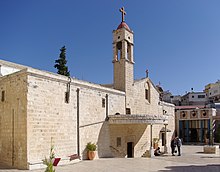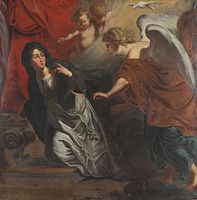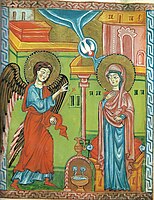Annunciation

TheAnnunciation(from theLatinannuntiatio;also referred to as the Annunciation to the Blessed Virgin Mary, the Annunciation of Our Lady,[1]or the Annunciation of the Lord;Ancient Greek:Ο Ευαγγελισμός της Θεοτόκου) is, according to theGospel of Luke,the announcement made by the archangelGabrieltoMarythat she would conceive and bear a son through avirgin birthand become the mother ofJesus Christ,theChristian MessiahandSon of God,marking theIncarnation.[2]

According toLuke 1:26the Annunciation occurred in the sixth month ofElizabeth's pregnancy withJohn the Baptist.Many Christians observe this event with theFeast of the Annunciationon 25March,[2]an approximation of the northernvernal equinoxnine full months beforeChristmas,the traditional birthday of Jesus.
The Annunciation isa key topic in Christian artin general, as well as inMarian art in the Catholic Church,having been especially prominent during theMiddle AgesandRenaissance.A work of art depicting the Annunciation is sometimes itself called anAnnunciation.
Religious sources[edit]

Gospel of Luke[edit]
TheGospel of Lukerecounts the Annunciation to the Blessed Virgin Mary:
And in the sixth month the angel Gabriel was sent from God unto a city of Galilee, named Nazareth, to a virgin espoused to a man whose name was Joseph, of the house of David; and the virgin's name was Mary. And the angel came in unto her, and said, Hail, thou that art highly favoured, the Lord is with thee: blessed art thou among women. And when she saw him, she was troubled at his saying, and cast in her mind what manner of salutation this should be.
And the angel said unto her, Fear not, Mary: for thou hast found favour with God. And, behold, thou shalt conceive in thy womb, and bring forth a son, and shalt call his nameJesus.He shall be great, and shall be called the Son of the Highest: and the Lord God shall give unto him the throne of his father David: and he shall reign over the house of Jacob for ever; and of his kingdom there shall be no end.
Then said Mary unto the angel, How shall this be, seeing I know not a man? And the angel answered and said unto her, The Holy Ghost shall come upon thee, and the power of the Highest shall overshadow thee: therefore also that holy thing which shall be born of thee shall be called the Son of God. And, behold, thy cousin Elisabeth, she hath also conceived a son in her old age: and this is the sixth month with her, who was called barren. For with God nothing shall be impossible. And Mary said, Behold the handmaid of the Lord; be it unto me according to thy word. And the angel departed from her.
Various Bible translations also give Gabriel's salutation as a variation on: "Hail, full of grace" (Luke 1:28,DRV). In this variation, commonly used by Roman Catholics, the archangelGabriel's greeting toMaryforms the first part of the prayerHail Mary.Mary's response to the archangel also forms the secondversicleand response of theAngelusprayer.
Gospel of Matthew[edit]

A separate, briefer and different annunciation is that given toJosephin theGospel of Matthew:
But while he thought on these things, behold, the angel of the Lord appeared unto him in a dream, saying, Joseph, thou son of David, fear not to take unto thee Mary thy wife: for that which is conceived in her is of the Holy Ghost. And she shall bring forth a son, and thou shalt call his nameJesus:for he shall save his people from their sins.
Apocryphal Gospel of James[edit]
There is a different version contained in theapocryphalGospel of James,which includes a first appearance of the archangel at the well.[n 1]
Manuscript 4Q246[edit]
Manuscript4Q246of theDead Sea Scrollsreads:
[X] shall be great upon the earth. O king, all people shall make peace, and all shall serve him. He shall be called the son of the Great God, and by his name shall he be hailed as the Son of God, and they shall call him Son of the Most High.
— Dead Sea scrolls manuscript Q4Q246, translated in "An Unpublished Dead Sea Scroll Text Parallels Luke's Infancy Narrative", Biblical Archaeology Review, April/May 1990[3]
It has been suggested that the similarity in content is such that Luke's version may in some way be dependent on the Qumran text.[4]
In the Quran[edit]

The Annunciation is described in theQuran,SurahMaryam,verses19:16–26.
Location[edit]
Both theRoman CatholicandEastern Orthodoxchurches hold that the Annunciation took place atNazareth,but differ slightly as to the precise location. Roman Catholic tradition holds that the Annunciation occurred in Mary's home, while Eastern Orthodox tradition holds that it occurred at the town well, known asMary's Well.TheBasilica of the Annunciationmarks the site preferred by the former, while theGreek Orthodox Church of the Annunciation(around half a mile away) marks that preferred by the latter.
Feast day[edit]
Western Christianity[edit]
TheFeast of the Annunciationis usually held on 25 March.[2]It is often translated in theCatholic Church,AnglicanandLutheranliturgical calendarswhen that date falls duringHoly WeekorEaster Weekor on a Sunday.[5]
When the calendar system ofAnno Dominiwas first introduced byDionysius Exiguusin AD 525, he assigned the beginning of the new year to 25 March since, according to Christian theology, the era ofgracebegan with theIncarnation of Christ.The first certain mentions of the feast are in acanonof the 656Council of Toledo,where it is described as celebrated throughout the Church.[2]The 692 Council of Constantinople "in Trullo"forbade observance of any festivals duringLent,exceptingSundayand the Annunciation. An earlier origin had been claimed for it on the grounds that it appeared in manuscripts of the sermons ofAthanasiusandGregory Thaumaturgusbut they were subsequently discovered to be spurious.[2]
Along with Easter, 25 March was historically used as theNew Year's Dayin many Christian countries.[6]The holiday was moved to January 1 inFrancebyCharles IX's 1564Edict of Roussillon.InEngland,the feast of the Annunciation came to be known asLady Day,[7]and Lady Day marked the beginning of the Englishnew yearuntil 1752.[7].
Eastern Christianity[edit]

This sectionneeds additional citations forverification.(February 2016) |
In theEastern Orthodox,Eastern Catholic,andOriental OrthodoxChurches, the Feast of the Annunciation is one of the twelve "Great Feasts"of theliturgical year,and is among the eight of them that are counted as "feasts of the Lord". Throughout the Orthodox Church, the feast is celebrated on 25 March. In the churches that use the new style Calendar (Revised JulianorGregorian), this date coincides with 25 March on the civil calendar, while in those churches using the old styleJulian calendar,25 March is reckoned to fall on 7 April on the civil calendar, and will fall on 8 April starting in the year 2100.Greek Independence Dayis celebrated on the feast of the Annunciation and 25 March is also a national holiday in the Lebanon.

The traditional hymn (troparion) for the feast of the Annunciation goes back toAthanasius of Alexandria.It runs:[8]
As the action initiating theIncarnation of Christ,the Annunciation has such an important place in Orthodox Christian theology that the festalDivine Liturgyof St.John Chrysostomis always celebrated on the feast, even if it falls onGreat and Holy Friday,the day when thecrucifixion of Jesusis remembered. The Divine Liturgy is celebrated on Great and Holy Friday only when the latter coincides with the feast of the Annunciation.[citation needed]If the Annunciation falls onPascha(Easter Sunday) itself, a coincidence which is calledKyriopascha,then it is celebrated jointly with the Resurrection, which is the focus of Easter. Due to these and similar rules, the rubrics surrounding the celebration of the feast are the most complex of all in Orthodox Christian liturgics.
Ephraim the Syriantaught that the date of the conception of Jesus Christ fell on 10Nisanon theHebrew calendar,the day in which the passover lamb was selected according toExodus 12(Hymn 4 on the Nativity). Some years 10 Nisan falls on 25 March, which is the traditional date for the Feast of the Annunciation and is an official holiday inLebanon.
In art[edit]
| Part ofa serieson the |
| Mariology of theCatholic Church |
|---|
 |
|
|
The Annunciation has been one of the most frequent subjects ofChristian art.[9][10]Depictions of the Annunciation go back to early Christianity, with thePriscilla catacombincluding the oldest known fresco of the Annunciation, dating to the 4th century.[11]It has been a favorite artistic subject in both the Christian East and as Roman Catholic Marian art, particularly during theMiddle AgesandRenaissance,and figures in the repertoire of almost all of the great masters. The figures of the virgin Mary and the angel Gabriel, being emblematic of purity and grace, were favorite subjects of Roman Catholic Marian art, where the scene is also used to represent theperpetual virginity of Maryvia the announcement by the angel Gabriel that Mary would conceive a child to be born theSon of God.
Works on the subject have been created by artists such asSandro Botticelli,Leonardo da Vinci,Caravaggio,Duccio,Henry Ossawa Tanner,Jan van Eyck,andMurilloamong others. The mosaics ofPietro CavalliniinSanta Maria in Trasteverein Rome (1291), thefrescosofGiottoin theScrovegni ChapelinPadua(1303),Domenico Ghirlandaio's fresco at the church ofSanta Maria NovellainFlorence(1486), andDonatello's gilded sculpture at the church ofSanta Croce, Florence(1435) are famous examples.
-
The Annunciationby Johann Christian Schröder,c. 1690
-
The AnnunciationbyPaolo de Matteis,1712,Saint Louis Art Museum,Saint Louis. Thewhite lilyin the angel's hand is symbolic of Mary's purity[n 3]inMarian art.[12]
-
The Annunciationin Armenian art by Toros Taronetsi, 1323
Music[edit]
Hans Leo Hasslercomposed a motetDixit Maria,setting Mary's consent.Johann Sebastian Bachand others composed cantatas forthe feast of the annunciationwhich is still celebrated in theLutheran Church,such asWie schön leuchtet der Morgenstern,BWV 1.
See also[edit]
- Angelus
- Annunciade,religious order
- Annunciation of Ustyug
- Basilica of the Annunciation
- Chronology of Jesus
- Expectation of the Blessed Virgin Mary
- Greek Orthodox Church of the Annunciation,Nazareth
- Incarnation (Christianity)
- Order of the Most Holy Annunciation
- Roman Catholic Marian art
- Perpetual Virginity of Mary
Notes[edit]
- ^For full text of the apocryphal Gospel of James, see for instancehereunder "Chapter 11: The Annunciation".
- ^In Eastern Orthodoxy, Mary is referred to asTheotokos(Greek:Θεοτόκος,fromΘεο,theo-,'God', andτοκος,tokos,'bearer').
- ^Purity is a wider concept thanvirginity,which is comprised within it, but which relates to a physical aspect only of purity.
Citations[edit]
- ^"Lessons for Holy Days » The Prayer Book Society of Canada".Prayerbook.ca. 23 March 2014. Archived fromthe originalon 9 October 2020.Retrieved27 March2014.
- ^abcdeEB (1878).
- ^Dead Sea scrolls manuscript Q4Q246, translated in "An Unpublished Dead Sea Scroll Text Parallels Luke's Infancy Narrative", Biblical Archaeology Review, April/May 1990
- ^VanderKam, James C.; Flint, Peter W. (2005).The meaning of the Dead Sea scrolls: Their significance for understanding the Bible, Judaism, Jesus, and Christianity.Continuum. p. 335.ISBN0-567-08468-X.
- ^Holweck, Frederick George (1907)..In Herbermann, Charles (ed.).Catholic Encyclopedia.Vol. 1. New York: Robert Appleton Company.
- ^Groves, Marsha (2005),Manners and Customs of the Middle Ages,p. 27
- ^abEB (1911b).
- ^Speaking the Truth in Love: Theological and Spiritual Exhortationsby John Chryssavgis, Ecumenical Patriarch Bartholomu 2010ISBN978-0-8232-3337-3page 85
- ^The Oxford Companion to Christian Art and Architectureby Peter Murray and Linda Murray 1996ISBN0-19-866165-7page 23
- ^Images of the Mother of God:by Maria Vassilaki 2005ISBN0-7546-3603-8pages 158–159
- ^LaVerdiere, Eugene (2007).The Annunciation To Mary.LiturgyTrainingPublications. p. 29.ISBN978-1-56854-557-8.
- ^Ross, Leslie (1996).Medieval Art: A Topical Dictionary.Bloomsbury Academic. p. 16.ISBN0-313-29329-5.
References[edit]
- Baynes, T. S., ed. (1878),,Encyclopædia Britannica,vol. 2 (9th ed.), New York: Charles Scribner's Sons, p. 90
- Chisholm, Hugh,ed. (1911),,Encyclopædia Britannica,vol. 2 (11th ed.), Cambridge University Press, p. 78
- Chisholm, Hugh,ed. (1911),,Encyclopædia Britannica,vol. 16 (11th ed.), Cambridge University Press, p. 62
Further reading[edit]
- Baxter, Roger(1823)..Meditations For Every Day In The Year.New York: Benziger Brothers.
- Knecht, Friedrich Justus (1910)..A Practical Commentary on Holy Scripture.B. Herder.


![The Annunciation by Paolo de Matteis, 1712, Saint Louis Art Museum, Saint Louis. The white lily in the angel's hand is symbolic of Mary's purity[n 3] in Marian art.[12]](https://upload.wikimedia.org/wikipedia/commons/thumb/9/9e/Paolo_de_Matteis_-_The_Annunciation.jpg/175px-Paolo_de_Matteis_-_The_Annunciation.jpg)

